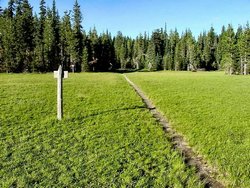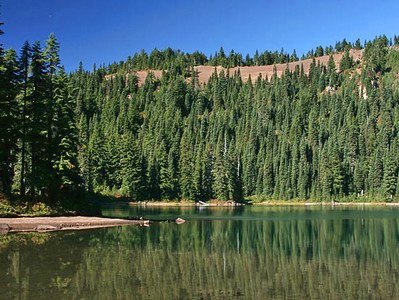Introduction
The United States Congress designated the Indian Heaven Wilderness
in 1984 and it now has a total of 20,782 acres. All of this wilderness
is located in Washington and is managed by the Forest Service.
Description
 A forested plateau dominated by fir (Pacific silver, noble, subalpine)
opens often into meadows splattered with at least 150 small lakes, ponds,
and marshes. Most of the larger lakes contain rainbow and brook trout.
Lava once flowed from almost every knobby rise above the plateau, which
averages 4,500 feet in elevation. The numerous volcanic cones reach their
highest point on Lemei Rock (5,927 feet), where a broad crater now contains
Lake Wapiki. A wealth of summer wildflower color is negated by the swarms
of biting insects born in the ubiquitous water. Deer and elk reside here
until winter snows drive them lower, along with black bears attracted to
the abundant ripening of fall huckleberries. Periodically over the past
9,000 years Indians (including the Yakama, Klickitat, Cascades, Wasco,
Wishram, and Umatilla tribes) gathered here for berry picking, fishing, and hunting.
A forested plateau dominated by fir (Pacific silver, noble, subalpine)
opens often into meadows splattered with at least 150 small lakes, ponds,
and marshes. Most of the larger lakes contain rainbow and brook trout.
Lava once flowed from almost every knobby rise above the plateau, which
averages 4,500 feet in elevation. The numerous volcanic cones reach their
highest point on Lemei Rock (5,927 feet), where a broad crater now contains
Lake Wapiki. A wealth of summer wildflower color is negated by the swarms
of biting insects born in the ubiquitous water. Deer and elk reside here
until winter snows drive them lower, along with black bears attracted to
the abundant ripening of fall huckleberries. Periodically over the past
9,000 years Indians (including the Yakama, Klickitat, Cascades, Wasco,
Wishram, and Umatilla tribes) gathered here for berry picking, fishing, and hunting.
The Pacific Crest National Scenic Trail (PCT) crosses the entire Wilderness
north-south for a distance of 16.4 miles, with several side trails to some of the
larger lakes and to the Indian Racetrack, a 2,000-foot-long field where horse
racing once provided a break from the tribal food-gathering routine. Seven other
trails enter from the east and west to join the PCT.
Indian Heaven Wilderness is 20,600 acres of broad, rolling country, straddling
the crest of the Cascade Range with subalpine meadows and 175 small lakes. Originally
known to the Indians as "Sahalee Tyee," the area has been and is culturally
important to Native Americans. "Indian Heaven" offers visitors wildlife
and panoramic views, as well as wildflowers and huckleberries, in season.
Indian Heaven Wilderness was created in 1984 as part of the Washington Wilderness
Bill. Located between Mt. Adams and the Columbia River Gorge, Indian heaven is
situated on a high plateau with numerous open meadows, forested areas, and more
than 150 lakes. Many of the lakes are stocked to provide good fishing for anglers.
The natural scenic beauty of Indian Heaven is enhanced by several interesting
volcanic formations such as East Crater and Lake Sahalee-Tyee. Lemei Rock is the
highest point in the area, at 5,927 feet, and provides majestic views of the Cascades
and Wapiki Lake.
Snow melts away in the area about mid-July. Fall is a good time to visit, with
brilliant colors flourishing, and the mosquito season nearly over. There are nearly
42 miles of trails providing a variety of backcountry travel experiences.
Who Passed This Way?
For almost 10,000 years, Native people have been traveling to what we now know
as Indian Heaven Wilderness. Archaeological evidence and historic records tell
us the area provided a wealth of resources for Northwest Tribes.

The Sawtooth Berry Field in the northern part of Indian Heaven Wilderness is
world renown for its wealth of huckleberries. The area was burned in the late
1890's and again in the Great Fires of 1902. The fields were subsequently maintained
by later fires, which may be attributed to Native Americans whose berry-drying
fires would escape. From 1902 to the mid-1920's, the area served as a famous summer
gathering place for Northwest Tribes. Much festivity, trading, and ritual surrounded
the annual huckleberry feast. The tribes would pick and dry huckleberries, race
horses, play games, make baskets, dry meat, tan hides, and fish in many lakes.
The local tribes included the Yakama, Klickitat, Wishram, Wasco, Cascade, and
Umatilla. Tribes from as far away as Montana and Wyoming also participated.
A council in 1932 between the Yakama Nation and the Forest Service resulted in a
handshake agreement, thereby designating part of the Sawtooth Berry Fields (east
of Road 24) as an area of exclusive use to the local Indian peoples.
The annual huckleberry harvest is still an important part of Native American
tradition. Please observe the signs reserving part of the berry fields for the
local tribes.
Huckleberry Legend
A Traditional Yakama Indian Legend

Long ago, this world was inhabited only by animals. The animals could talk
and understand each other, and they were just like we are today. One day the Creator
called everyone together and said, "There are new people coming to live on
this earth. You must make room for them by selecting new names and identities.
You have the choice of what you want to be in this new world, and I will help
you."
The animals all declared what they wanted to be in the new world. The Creator
asked each one to perform certain feats in order to qualify for their new identity.
If an animal failed to perform the feat he had to choose something else for which
he was better qualified.
Coyote, as usual, monopolized all the best choices, but each time he could
not perform the feat. First, he wanted to be the eagle, but he was unable to fly
high in the sky, and did not have the keen eyesight the eagle must have. Next,
he wanted to be the salmon, but he could not swim well enough. At last, the only
position he could qualify for was the plain old Coyote, which he is today.
Every time an animal qualified for what he wanted to be, the Creator took part
of his body and placed in the new creature. For this reason, the Indian people
respect everything that has life, be it plant, animal, or human, because they
are all part of the Creator.
When the Creator was finished with his work, he looked and say that he did
not have any berries in the mountains. The only part of his body that was left
were his eyes. So, he took his eyes and put them into the ground in the mountains.
The veins in his eyes bled into the earth and become the roots. The roots became
the plant, and the berries sprouted and became the huckleberries.
Permits
Remember, Wilderness Permits are required when you enter any wilderness area in the Gifford Pinchot National Forest.
Click Here for more information.
Rules
Click Here for PDF on Restrictions
Gifford Pinchot
Oh, by the way, who was Gifford Pinchot?
Click Here for more information.